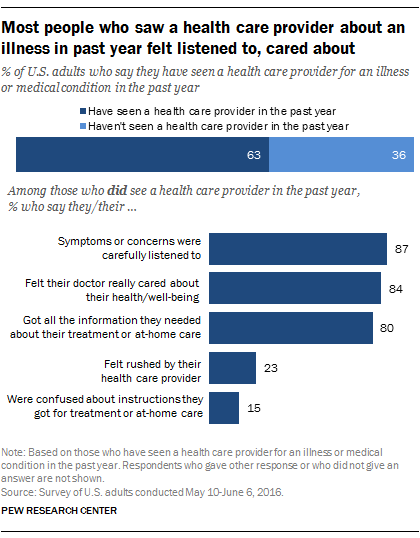Most U.S. consumers support the idea of price-shopping for healthcare, but don’t practice it. While patients “should” shop for health care and perceive differences in costs across providers, few seek information about their personal out-of-pocket costs before getting treatment.
Few Americans shop around for health care, even when insured under a high-deductible health plan, conclude Ateev Mehrotra and colleagues in their research paper, Americans Support Price Shopping For Health Care, But Few Actually Seek Out Price Information. The article is published in Health Affairs‘ August 2017 issue.
The bar chart shows some of the survey results, with the top-line finding that 7 in 10 consumers believe it’s important to consider out-of-pocket costs when choosing a doctor, and patients comparing costs and/or quality would be “good for our country.” To the right, note that the vast majority of consumers do not link high health care prices to better quality health care.
The price-shopping challenge is important to address because out-of-pocket health care spending is fast-growing, up 41% between 2010 and 2014. Workers’ wages stayed relatively flat over that period, so the fiscal “bite” that health care costs take out of household incomes has grown relatively to other line items in the family budget.
There are more price transparency tools available to prospective health care shoppers, the researchers note, available to both private and public sources (an example of the former, Castlight Health, offered to employers; and state-furnished sites like NH HealthCost).
Even the uptake of high-deductible health plans among health-insured people hasn’t driven the mass of consumers to price-shop using these price-revealing tools. Specifically, among consumers with out-of-pocket spending:
- 52% of consumers were aware of price before they received care
- 13% searched in advance for their expected out-of-pocket outlays
- 10% considered going to another provider
- 3% compared costs across providers
- Among the 13% who conducted research into out-of-pocket spending before a visit, 63% called providers for information, 25% used a website sponsored by their health plan/employer/public site, and 9% call their health plan
- Non-Hispanic Black people (63%) wee more likely to be aware of price before care versus non-Hispanic white people (54%) and Hispanic people (49%)
- Price-comparing in health care also varied by site of the care: consumers were more likely to search health care costs across providers for physical therapy, lab tests or imaging services; and to search for cost information before a procedure in an ambulatory surgery center.
Based on this survey, most consumers still find it difficult to locate information on health care prices, which is consistent with other research from the Kaiser Health Tracking Poll and Public Agenda.
The study was conducted using a national sample of U.S. adults ages 18-64 who have received medical care in the past twelve months (KnowledgePanel from GfK).

Still, the researchers found that consumers were more likely to seek cost information for higher-cost services (like outpatient surgery), and for non-urgent services such as physical therapy.
Employers, who will continue to sponsor health insurance for the new few years, are tweaking health plans and financial incentives to nudge workers toward lower-cost settings for healthcare. The latest Willis Towers Watson report on employer-sponsored health benefits, published last week, found that companies are incorporating more virtual healthcare (telehealth and telemedicine) and mobile health programs into benefits to provide access to convenient care at lower price points. Nine in 10 employers in the U.S. was looking to offer telehealth services to employees by 2020, the National Business Group on Health found.
The challenge still remains for patients, still evolving health consumer muscles, in this ironically-named era of “consumer-directed healthcare.”
The post Price-Shopping for Healthcare Still A Heavy Lift for Consumers appeared first on HealthPopuli.com.
Article source:Health Populi
No comments:
Post a Comment